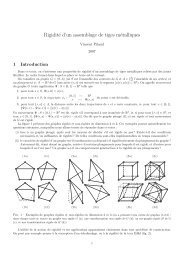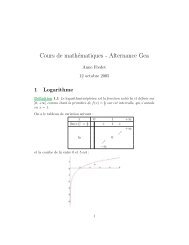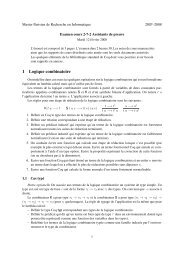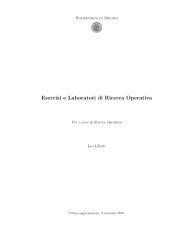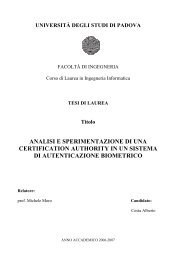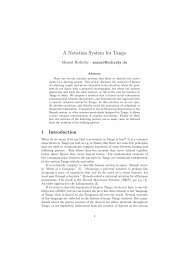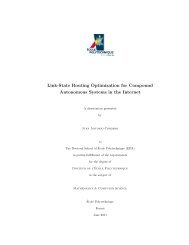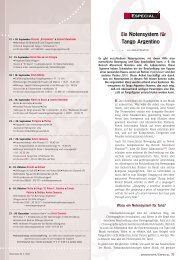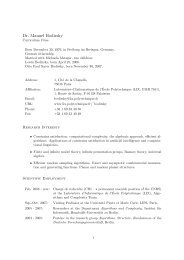(Un)trusted Intermediaries in CoAP - Lix
(Un)trusted Intermediaries in CoAP - Lix
(Un)trusted Intermediaries in CoAP - Lix
You also want an ePaper? Increase the reach of your titles
YUMPU automatically turns print PDFs into web optimized ePapers that Google loves.
(<strong>Un</strong>)<strong>trusted</strong> <strong>Intermediaries</strong> <strong>in</strong> <strong>CoAP</strong><br />
Thomas Fossati ∗ , Angelo P. Castellani † , Salvatore Loreto ‡<br />
1 Problem Statement<br />
February 16, 2012<br />
End-to-end secure communication as specified <strong>in</strong> <strong>CoAP</strong>, either DTLS or IPsec, is feasible only<br />
if direct communication is possible with the peer endpo<strong>in</strong>t. If one or more <strong>in</strong>termediaries are<br />
<strong>in</strong>volved <strong>in</strong> the process, either upper-layer object security must be adopted or total trust on the<br />
<strong>in</strong>termediate proxies is required to preserve the security of the communication.<br />
Based on the current specification [1], the only feasible option to build a secure tunnel between<br />
the endpo<strong>in</strong>ts is to create a cha<strong>in</strong> of <strong>in</strong>dependent trust l<strong>in</strong>ks equal to the number of traversed<br />
proxies, hence achiev<strong>in</strong>g the end-to-end trust transitively. This is equivalent to stat<strong>in</strong>g that the<br />
end node has to eventually trust all the <strong>in</strong>volved <strong>in</strong>termediaries <strong>in</strong> between the endpo<strong>in</strong>ts.<br />
Moreover, different trust l<strong>in</strong>ks along the path from end to end may show different security<br />
modes. In fact, even if a client endpo<strong>in</strong>t uses DTLS with the <strong>in</strong>termediary, the <strong>in</strong>termediary<br />
itself can use IPsec or even NoSec mode on the follow<strong>in</strong>g l<strong>in</strong>k. This may be typical <strong>in</strong> case the<br />
<strong>in</strong>termediary wants to enable secure communication features to constra<strong>in</strong>ed devices that natively<br />
do not support them, e.g. very limited class-1 devices miss<strong>in</strong>g the hardware resources required.<br />
On the other hand, this approach may <strong>in</strong>troduce vulnerabilities to the whole path <strong>in</strong> case the<br />
security policy enforced on a given l<strong>in</strong>k is not adequate.<br />
It is also worth not<strong>in</strong>g that [1] is not clear about how a coaps request to a proxy works (i.e.<br />
whether to use the client or the proxy credentials to create the DTLS connection), especially <strong>in</strong><br />
case the proxy forwards the request to another proxy <strong>in</strong>stead of send<strong>in</strong>g it to the server specified<br />
by the absolute-URI.<br />
Which mechanisms can be envisaged <strong>in</strong> order to allow secure and transparent end-to-end communication<br />
us<strong>in</strong>g the <strong>CoAP</strong> protocol ? Is it possible to remove, or at least reduce, the amount<br />
of trust that end nodes <strong>in</strong> a <strong>CoAP</strong> network have to put <strong>in</strong> the proxy nodes ? How and at what<br />
price can this be atta<strong>in</strong>ed ?<br />
This short paper tries to provoke some th<strong>in</strong>k<strong>in</strong>g about this seem<strong>in</strong>gly open question, and to<br />
provide a tentative answer <strong>in</strong> terms of what is currently available or miss<strong>in</strong>g <strong>in</strong> current <strong>CoAP</strong><br />
specification, what could be added to circumvent the issue, and what the engendered ramifications<br />
are.<br />
∗ KoanLogic, tho@koanlogic.com.<br />
† Consorzio Ferrara Ricerche (CFR), DEI – <strong>Un</strong>iversity of Padova, castellani@dei.unipd.it.<br />
‡ Ericsson, salvatore.loreto@ericsson.com.<br />
1
1.1 Secure HTTP-<strong>CoAP</strong> mapp<strong>in</strong>g<br />
The problem stated <strong>in</strong> Section 1 applies especially if one of the endpo<strong>in</strong>ts is us<strong>in</strong>g HTTP, and thus<br />
an HC proxy [2] is <strong>in</strong>volved <strong>in</strong> the path, s<strong>in</strong>ce TLS and DTLS can’t be seamlessly bridged.<br />
The HC proxy must have a security policy mapp<strong>in</strong>g <strong>in</strong> place to translate from the TLS security<br />
mode of operation used <strong>in</strong> HTTPS to any security mode available on the path to the requested<br />
<strong>CoAP</strong> resource. Depend<strong>in</strong>g on the deployment, security on the <strong>CoAP</strong> path might not be required,<br />
or could be guaranteed by means of other mechanisms, e.g. layer 2 security; <strong>in</strong> this context <strong>CoAP</strong><br />
communication could even be implemented us<strong>in</strong>g the NoSec security mode.<br />
2 Introduc<strong>in</strong>g the <strong>Un</strong><strong>trusted</strong> Proxy<br />
Though at least one documented MitM attack on (D)TLS exist [3], it is believed that current<br />
(D)TLS specification and its most widespread implementations (i.e. at least OpenSSL and<br />
GNUTLS) are immune to such risk, which would abrogate – by def<strong>in</strong>ition – any chance to reduce<br />
the amount of trust that depend<strong>in</strong>g nodes must put onto <strong>in</strong>termediaries.<br />
Given this essential premise, the only possibility currently left to the constra<strong>in</strong>ed node to do<br />
end-to-end security <strong>in</strong> the depicted sett<strong>in</strong>g, is to use some k<strong>in</strong>d of so called object security, i.e.<br />
protect the messag<strong>in</strong>g contents, and communicat<strong>in</strong>g endpo<strong>in</strong>ts identities, by means of a tamper<br />
proof envelope such as [4] or [5]. This could result <strong>in</strong> more chubby and complex implementation,<br />
and be easily vulnerable to replay attacks unless well def<strong>in</strong>ed.<br />
At present, what seems to be miss<strong>in</strong>g <strong>in</strong> <strong>CoAP</strong> to atta<strong>in</strong> end-to-end security while m<strong>in</strong>imiz<strong>in</strong>g<br />
the trust on proxy nodes, is some sort of bypass facility by which end nodes could communicate<br />
travers<strong>in</strong>g the cha<strong>in</strong> of <strong>in</strong>termediaries transparently, e.g. one that mimics the semantics of the<br />
CONNECT method <strong>in</strong> HTTP.<br />
Provision<strong>in</strong>g <strong>CoAP</strong> with such facility would allow direct communication with <strong>trusted</strong> nodes<br />
deployed on an un<strong>trusted</strong> network even without direct connectivity to them, by rely<strong>in</strong>g on a<br />
<strong>CoAP</strong> <strong>in</strong>termediary to provide such “restrict” communication facility, bl<strong>in</strong>dly forward<strong>in</strong>g packets<br />
until the associated security context is dra<strong>in</strong>ed.<br />
2.1 Ramifications<br />
The implications of such <strong>in</strong>crease <strong>in</strong> power are rather <strong>in</strong>terest<strong>in</strong>g, and need to be weighted<br />
carefully when practically tak<strong>in</strong>g <strong>in</strong>to consideration the <strong>in</strong>troduction of a CONNECT-like method<br />
<strong>in</strong> <strong>CoAP</strong>.<br />
Security Policy Bypass. By allow<strong>in</strong>g an end node to use a CONNECT-like facility, a security<br />
exception is <strong>in</strong>troduced natively <strong>in</strong>to the architecture, which quite reverses the established trust<br />
relationships. Now the proxy has to be confident <strong>in</strong> the end node, which is permitted, <strong>in</strong> pr<strong>in</strong>ciple,<br />
to bypass the security policy implicitly set by the proxy role and topological position. Hence, the<br />
availability of such facility def<strong>in</strong>itely needs to be constra<strong>in</strong>ed by white/black-list<strong>in</strong>g of <strong>in</strong>tended<br />
sources and targets.<br />
2
Bootleg PCP. Lack<strong>in</strong>g an access control mechanism based on strong authentication primitives<br />
(e.g. us<strong>in</strong>g one based on simple network locators), the added functionality could be trivially<br />
abused <strong>in</strong> more than one disruptive way, e.g. to build a fraudulent Port Control Protocol. Note<br />
that devices will<strong>in</strong>g to do end-to-end security already have the needed computational resources<br />
to exchange strong identities with the proxy node, so this should be affordable at no additional<br />
cost.<br />
Cache Elusion. Another side-effect is the elusion of the cach<strong>in</strong>g function. Note that s<strong>in</strong>ce<br />
resources are requested from the coaps scheme, the cache is weakened <strong>in</strong> any case s<strong>in</strong>ce “secure”<br />
resources are not (publicly) cacheable by their own nature. But this is stronger s<strong>in</strong>ce, <strong>in</strong> this case,<br />
the cache is fully eluded, blow<strong>in</strong>g away one of the fundamental functions of the proxy.<br />
References<br />
[1] “Constra<strong>in</strong>ed Application Protocol (<strong>CoAP</strong>)”, Z. Shelby, K. Hartke, C. Bormann, B. Frank,<br />
November 2011.<br />
[2] “Best practices for HTTP-<strong>CoAP</strong> mapp<strong>in</strong>g implementation”, Angelo P. Castellani, Salvatore<br />
Loreto, Akbar Rahman, Thomas Fossati, and Esko Dijk, October 2011.<br />
[3] “Renegotiat<strong>in</strong>g TLS”, Marsh Ray, Steve Dispensa, November 2009.<br />
[4] “Cryptographic Message Syntax”, R. Housley, STD 70, RFC 5652, September 2009.<br />
[5] “Javascript Object Sign<strong>in</strong>g and Encryption Charter”<br />
3



